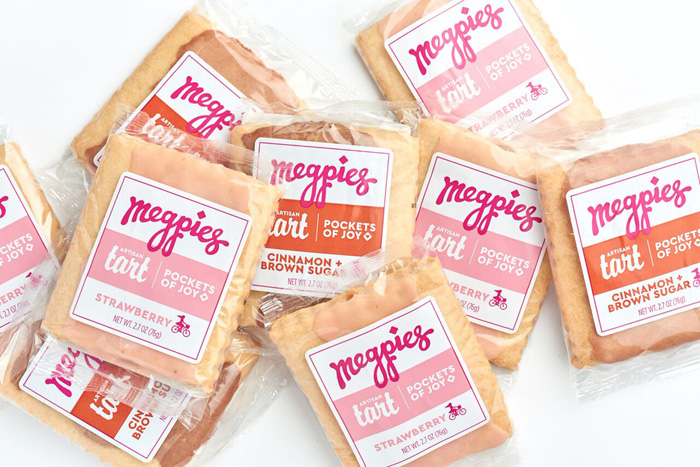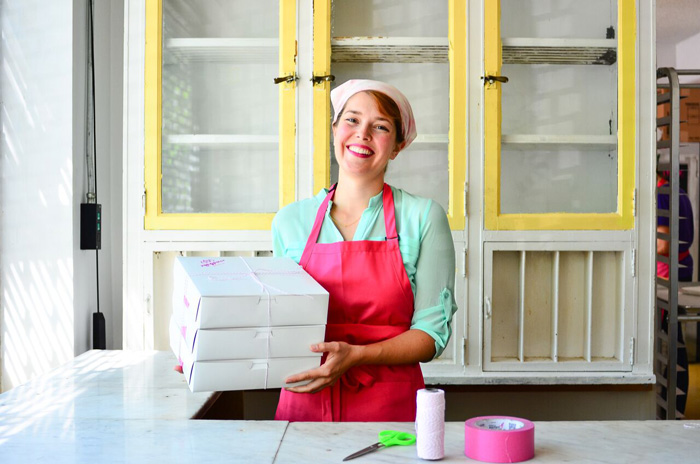How Megpies Went from Front Stoop to Starbucks
The recipe for Meghan Ritchie’s wildly popular tarts has a secret ingredient: her own persistence
This Brooklyn confection is now in 7,500 Starbucks outlets. Cinnamon is a favorite flavor. (Photo credit: Courtesy of Megpies)
When Meghan Ritchie began selling baked goods on her Park Slope stoop, she did it because, well, she liked baking and chatting with her neighbors. She wasn’t entertaining the idea that Starbucks CEO Howard Schultz would walk by one day, taste her homemade tarts and scones, and say, My god, you’ve really got something here!
And he didn’t. That’s not how these types of stories go. Here’s the truth behind Megpies, Ritchie’s homemade, fancy Pop Tart-like treat that enjoyed a meteoric rise from stoop sales to local cafes to their eventual pairings with Frappuccinos and prominent placement next to the cash registers in 7,500 Starbucks around the U.S. The truth is it takes a lot of work to make a so-called overnight success look easy.
There is a tendency to sugarcoat (sorry) being an entrepreneur. Making your own hours and being your own boss sounds glorious to people unhappy in their own jobs, but the reality is much different. Success usually comes from a series of tiny steps and strategic seizing of opportunities, rather than, say, being miraculously discovered by a wealthy benefactor. And there’s no passing the buck. The founder of a company can never utter the phrase, “Sorry, that’s above my pay grade.” These are all lessons that Ritchie and her business and life partner Paul Jones learned during their five-year journey of developing Megpies Tarts.
The First Batches of Megpies
Like most creative ideas, this one started with a few key ingredients. Ritchie was selling scones and baked goods on her stoop for fun and working at a jam company by day when her employer suggested she incorporate their product with her part-time hobby. She toyed around with products that could be consumed on the go—her customers were busy New Yorkers, after all. The resulting thick, jam-filled tart with a thin sheen of icing hit the sweet spots of nostalgia (childhood memories!) and indulgence (that buttery crust!). Brooklynites ate them up.
Megpies debuted at the Smorgasburg food market in 2012, and later into local Brooklyn shops and cafes, despite Ritchie’s claim that she’s “the worst salesperson in the world. I would go into a cafe and say, ‘Hey, you don’t really want these tarts, do you?’”

Meghan Ritchie with her partner Paul Jones, who handles outreach and sales. (Photo credit: Courtesy of Megpies)
Despite that soft sell she managed to capture four or five accounts and was suddenly baking 300 tarts each week. After Jones officially joined as co-founder in charge of sales, his first account was the Ace Hotel in Manhattan. As Jones says, “The biggest lesson for me was that we are the only ones who are responsible.” That means when a last-minute order came in, they’d stay up all night. If Ritchie had already baked and frosted and finished up for the night, but realized they were missing a few dozen tarts, she’d start the process all over again. The shelves in their freezer would collapse under the weight of the tarts; Jones had to bungee cord the door closed every night.
Other cafes and specialty stores followed suit, and they jumped from making 300 tarts a week to 3,000. They were gonna need a bigger freezer.
In order to scale up their recipe, they considered their options. Taking out $2 million in loans to build a facility with walk-in freezers was quickly nixed. Instead, they turned to co-manufacturing in Sunset Park, where an experienced baker with more resources could help expand the business and figure out major details like tweaking the recipe for mass production. Exactly how much butter should be put in that much dough?
“It was literally four years of really hard work before we knew we were going to be in Starbucks and five years before we were,” says Ritchie, who would often wake up at 2 a.m. and go to work prepping and baking, while Jones—who’s not a morning person, Ritchie says with a laugh—would hop on the bike for deliveries at 6 a.m. They did this for years while seeing virtually no income from their product, bootstrapping the operation and paying their rent through babysitting gigs, voiceover work, and late nights as a server and bartender. Plenty of people want to start their own businesses, but how many would bolt upright in the middle of the night to start mixing frosting?
Keeping the Faith
Every time they thought of quitting along the way, an opportunity snuck up on them. A friend offered use of a bakery space on Manhattan’s Lower East Side. Ritchie’s parents gave them a car when the bicycle wasn’t cutting it. And then there was the greatest reason of all to keep going: faith in the product and their progress.
But the biggest champions might have been the support system they found through local business owners in Brooklyn. “Relationships are everything,” says Jones. “If we didn’t have the support of those local Brooklyn cafes, we wouldn’t be here.” Hustle recognizes hustle. Recalling their early Smorgasburg days when the food market was far from the slick event it is now, they remember the owner of BBQ restaurant Mighty Quinn’s staying up for two days straight smoking meat, and getting his first branded sign. Now that BBQ shop has eight restaurants around New York and New Jersey, and four international locations. “It was community that you could look to and realize they’re going through the same thing,” says Jones. “You’re not so isolated in the struggles you run up against.”

At first, Ritchie handled all the baking. Now she focuses on shipping, packaging and growth. (Photo credit: Courtesy of Megpies)
Ritchie also used to work seasonally at One Girl Cookies in Cobble Hill decorating Christmas cookies, and in Megpies’ early days, the bakery owners acted as de facto mentors. “People are so much more willing to help than you’d think,” says Ritchie. “It’s not that competitive.”
Even the Starbucks partnership started slowly. Its new division of retail branded partnerships—corporate-speak for saying they find talented local entrepreneurs and groom them to scale up their recipes to sell in Starbucks all across the land—approached Ritchie and Jones in 2014 and Megpies got a test run in a few New York stores. That early success lead to 30 more stores and then, eventually, to where they are today.
Baking on a Big Scale
Once Starbucks and Whole Foods came knocking, the Megpies partners realized their Sunset Park co-manufacturing process couldn’t provide enough product for a national launch. So they found an even bigger and more experienced family-owned company that allowed them to scale at a much faster rate, while still sticking to the original Megpies recipe. Their chocolate, cinnamon, and strawberry artisanal tarts weren’t suddenly going to be pumped with preservatives or corn syrup.
With the huge facility came the ability to go big. Hundreds of thousands of tarts big, which are flash-frozen and thawed at Starbucks around the U.S. Now that Ritchie isn’t handling the day-to-day baking, she’s deep into logistics of shipping, packaging and growing the business, with Jones managing outreach and sales.
Even now, Ritchie will go into Starbucks and ask the baristas if they’ve tried the Megpies sitting right in front of them—and if they haven’t, she’ll buy one for them. She wants the people selling her product to actually know about it.
The Business Plan: Just Do It
As for advice to other Brooklyn would-be entrepreneurs, Ritchie invokes a call to action: Just do it, don’t think about it too much, then “pivot when you need to pivot.” When a cafe asked her for an invoice for her first big sale, Ritchie didn’t know how to bill them but opened up a Word doc and figured it out. A Whole Foods executive loved cinnamon-flavored Pop-Tarts and asked if Ritchie would try making a cinnamon version of her treat. She did; it’s now their best seller. They didn’t even have a business plan until after they were in Starbucks.
The next logical step, of course, is to keep growing. They’re looking to expand into grocery stores with a regional rollout, and so continues the happy grind of traveling, doing demos, and handing out plenty of samples. And finally, after five years and quite literally a few million tarts, Megpies is about to hire its first employee: Ritchie’s old roommate who started back on the stoop with her. For a growing company who won’t quite shake where they came from, keeping the business close to home sounds about right.










